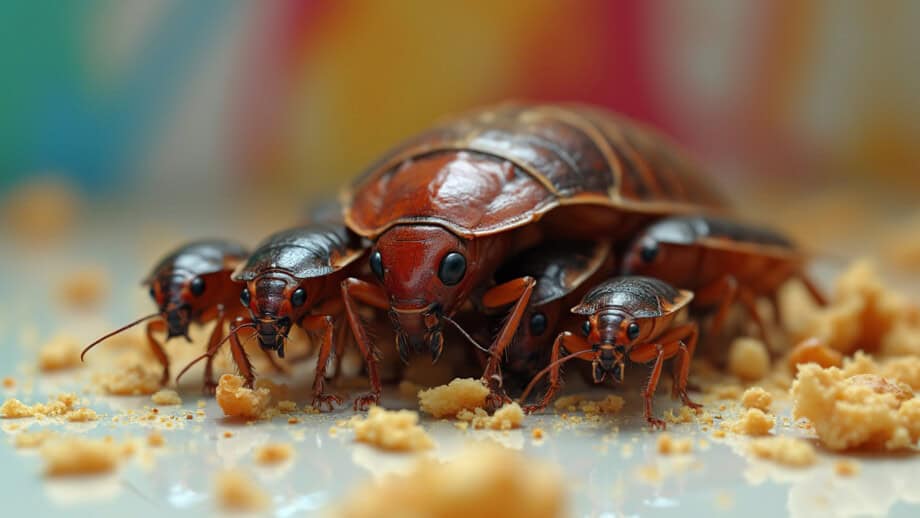There is nothing more horrifying than seeing cockroaches run across your floor, which begs the question of what do baby cockroaches look like and how dangerous are they?
Baby cockroaches, also known as cockroach nymphs, can be just as dangerous as their adult counterparts, as they spend their time crawling through pipes and eating their own feces, as well as carrying several disease-causing viruses, bacteria, and other pathogens.
Nymph cockroaches are unable to fly because their wings are not fully grown until the insect reaches maturity. Baby cockroaches can’t fly, so they jump or scurry to safety in cracks, crevices, or other inaccessible areas.
If you’ve seen one of these pests inside your home, there’s probably a nest nearby, which means you may already have an infestation or are on the verge of getting one.
In this article, we’ll tell you what baby roaches look like and how to tell them apart, so you can keep these pests out of your home and out of your mind.
What Do Baby Cockroaches Look Like?
Baby roaches usually look like small versions of adult roaches. Cockroaches come in a wide range of shapes and sizes, and their appearance might change depending on the species and developmental stage you’re dealing with.
The average cockroach nymph is between 1/8 and 1/4 of an inch long, and their color can range from light brown to dark brown. Baby roaches hatch out white or light grey, but they soon deepen in color after a few hours.
Baby roaches, like their adult counterparts, have flat, hard-shelled bodies. As they move through various developmental phases known as instars, they molt and grow new exoskeletons.
The average American cockroach, for example, travels through 10–13 instar stages before reaching maturity, however this range is very variable depending on species and environmental factors.
Baby roaches typically do not have wings. Instars of some cockroach species may have partially grown wings visible on their back, whereas instars of other species may not have any wings at all. Cockroaches don’t develop functioning wings until they are fully grown, and some species, like the German cockroach, have wings but are unable to fly even as adults.
All baby cockroaches, regardless of species, have two long, thin antennae and six spiny legs. But at earlier stages, the legs and antennae might be too small or thin to see clearly. Depending on the species, their length and appearance may also vary.
As they grow, baby cockroaches start to look more and more like small versions of full-grown cockroaches, with long, spiny legs and antennae that are almost as long as their bodies.


Are Baby Cockroaches Dangerous?
Don’t judge a baby cockroach by how big it is. These cockroaches continue to represent a risk to you and your home. They can spread disease just like adult cockroaches and pose a threat to food safety. It won’t be long before these cockroaches reach maturity.
German cockroaches prefer to live indoors, while American cockroaches live outside and come inside to find food and shelter. They reproduce in concealed spaces, making identification and treatment of an infestation challenging.
Is Seeing One Baby Cockroach a Problem?
If you see one baby cockroach, it might not seem like a big deal, but it could be a sign of a bigger problem and potentially an infestation. Rarely will you find a cockroach nymph all by itself.
Adult female cockroaches can reproduce rapidly. They lay egg cases known as oothecae, which can hold up to 50 eggs depending on the species. Through the course of their adult lives, they can lay anywhere from 6 to 30 cases.
Due to their short lifespans, cockroaches can generate a large number of offspring quickly, which might result in an infestation.
As these cockroach babies grow up, they will start to reproduce as well. This will increase the population even further. This makes controlling a cockroach infestation difficult.
Common Species of Baby Cockroaches
The appearance of baby cockroaches differs between species. If you’re trying to figure out what kind of cockroach nymphs you’re dealing with, read on to learn the difference in appearance between different cockroach species:
Baby American Cockroaches
When they hatch, baby American cockroaches are usually less than 1/4 inch long, or about the size of a grain of rice. As they molt and advance through the instar stages, they reach approximately 2 inches in length as adults.
American cockroach nymphs change color gradually as they grow. When they first hatch, roach babies are pale and white-grey, but over the next few hours, they change color to a reddish brown.
Baby American cockroaches are easy to spot because their shells have a reddish-brown color and they have a halo-shaped mark behind their heads.
Baby German Cockroaches
Compared to their American counterparts, German cockroaches are significantly smaller.
Baby German roaches can be as small as 1/8 of an inch long when they hatch. Even as adults, they only grow to a maximum length of 1/2 to 2/3 inches.
Typically, German cockroaches undergo six to seven instar stages. As they develop and molt through the various instar stages, their coloration shifts from a very light whitish-grey to a tan or light brown.
Baby German cockroaches can be identified by the two parallel dark stripes that run lengthwise down the protonum which is the plate-like structure behind their heads.
Baby Oriental Cockroaches
Baby Oriental cockroaches, like baby American cockroaches, are around 1/4 inch in length when they first hatch out.
At adulthood, they reach a size of about 1 to 1 1/2 inches, making them larger than German cockroaches but smaller than their American counterparts.
Baby Oriental cockroaches, like the other two species, start out white but quickly develop a pale-brown color. As Oriental roaches grow up and shed their skin, this brown color turns a little bit red.
The pattern of horizontal light and dark bands running across the backs of baby Oriental roaches is their most recognizable feature.
Baby Cockroaches vs. Bed Bugs
Due to their size and appearance, roach babies and nymphs are sometimes mistaken for other pests, particularly bed bugs.
In case you’re trying to figure out which pest you’re dealing with, here are some important distinctions between bed bugs and baby cockroaches:
Shape: The easiest way to tell these two pests apart is their shape. Bed bugs have short, oval bodies and they are significantly flatter than young roaches. In contrast, cockroach larvae have cylindrical or oblong bodies that resemble a grain of rice.
Eyes: You can also tell the difference between bed bugs and baby roaches by looking at their eyes. The eyes of bed bugs are distinct dark spots that protrude from the sides of their heads. On the other hand, even though cockroach babies have eyes, they aren’t as obvious.
Antennae: Looking at the antennae is another good way to tell the difference between a baby cockroach and a bed bug. Compared to bed bugs, baby cockroaches have antennae that stick out in front of them and are nearly as long as their body. Bed bugs, in contrast, have small antennae that protrude to the side.
Location: Where these insects hide is another important clue that can help identify them correctly. Baby roaches tend to live near food and water sources, especially in dark or damp places. Bed bugs tend to live in and around your mattress.
How to Get Rid of Baby Cockroaches

You can help keep cockroaches out of your home by taking some preventative measures, along with other measures to get rid of them.
Cockroaches come into homes to find food, water, and a place to live. By getting rid of these things, they won’t want to stay in your home. Here’s how to do that:
Clean Regularly
Keeping your home clean is an important step in preventing baby cockroaches. Make sure to vacuum, mop, and wipe down surfaces regularly to get rid of any food or water sources that might attract roaches. In addition, don’t forget to empty the garbage and take out the trash frequently.
Pick Up Pet Food
One of the most common sources of food for cockroaches is pet food. To reduce the chances of baby cockroaches entering your home, make sure to pick up your pet’s food immediately after they finish eating.
Roaches are attracted to open containers of pet food and will use it as a meal if given the chance. Additionally, keep pet food bowls sealed in plastic containers when not in use.
Seal Up Cracks and Crevices
Cockroaches are small enough to squeeze through tiny gaps and cracks in your walls, doors, and windows. To keep them out of your home, look for any potential entry points and seal them up with caulk or a similar material.
Remove Clutter
Removing clutter is another important step in preventing baby cockroaches. Clutter creates hiding spots for roaches and provides them with easy access to food and water.
To reduce the chances of cockroaches entering your home, make sure to remove any unnecessary clutter from your home, including stacks of paper or cardboard boxes.
Eliminate Moisture
Roaches need a moist environment to survive, so it’s important to reduce any sources of moisture in your home.
This includes fixing leaky faucets, unclogging any slow-draining sinks, and using a dehumidifier in damp areas like basements and bathrooms. Also, make sure to replace your pet’s water bowl frequently so as not to attract any cockroaches.
Use Insect Growth Regulators
Insect growth regulators, or IGRs, can be used to slow the growth of cockroach nymphs to stop them from developing into adults and reproducing.
To help manage the infestation, you can use conventional cockroach control solutions like boric acid or diatomaceous earth.
Related Articles from Planet Natural:
Cockroach Control: Get Rid of Cockroaches Step-by-Step
Palmetto Bug Or Cockroach: Differences & How to Kill Them
Water Bugs: What Are They Exactly and How to Get Rid of Them











